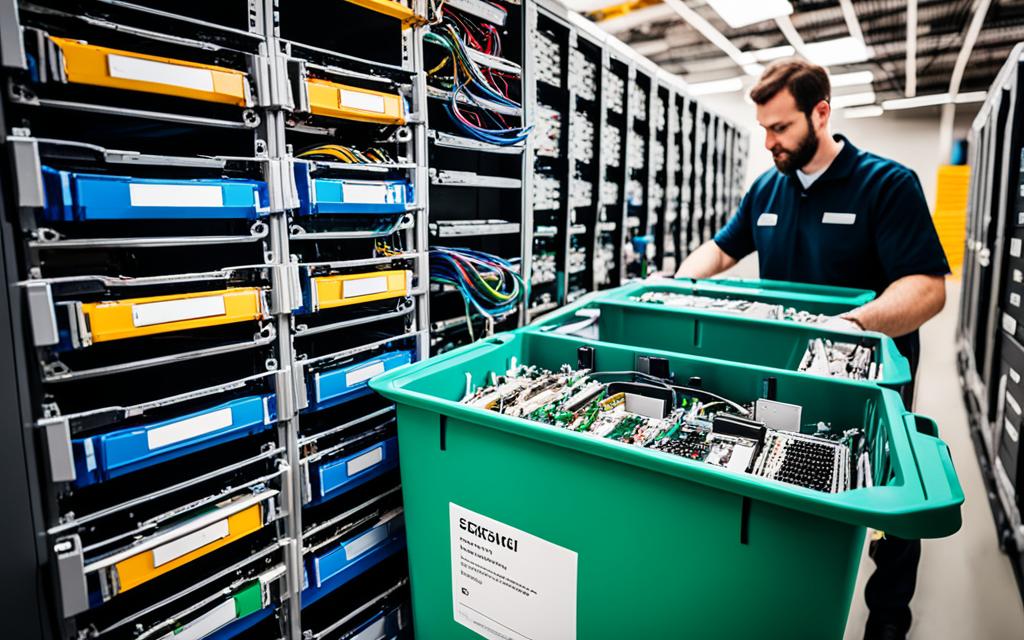A Comprehensive Guide on How to Decommission a Server: Focusing on Windows Servers
Welcome to our comprehensive guide on how to decommission a server with a special focus on eco-friendly strategies. Server decommissioning is a critical process that involves taking servers offline safely and effectively, often at the end of their lifecycle. The importance of this process cannot be overstated, as improper decommissioning can lead to data breaches, compliance issues, and unnecessary costs.
In today’s world, where sustainability is more important than ever, we also aim to shed light on eco-friendly strategies for server decommissioning. These strategies not only help in reducing the environmental impact but also often prove to be cost-effective in the long run.
This article will cover a range of topics, from the general steps involved in server decommissioning to how to decommission a Windows server specifically. We’ll also delve into eco-friendly strategies, common pitfalls to avoid, and additional resources to make the process as smooth as possible.
By the end of this guide, you’ll have a well-rounded understanding of server decommissioning, equipped with the knowledge to carry it out in an eco-friendly manner.
Why Server Decommissioning Matters
The Lifecycle of a Server
Every server has a lifecycle, beginning with its initial setup and ending with its decommissioning. The average lifespan of a server is around 3 to 5 years, although some can last longer depending on usage and maintenance. Understanding this lifecycle is crucial for efficient IT management and planning.
Risks and Costs of Negligence
Failure to properly decommission a server can lead to a host of problems. One of the most significant risks is data security. Old servers often contain sensitive information that can be exploited if not properly erased. Additionally, outdated servers are more vulnerable to cyber-attacks as they may not receive regular security updates.
What Does “Decommissioning” Mean?
The term “decommissioning” is a general term for a formal process to remove something from active status. In the context of servers, this means taking the server out of operation and ensuring that it is either repurposed, recycled, or properly disposed of. For more on the general concept of decommissioning, you can refer to this Wikipedia article.
Preparing for Server Decommissioning
Backup and Data Migration
Steps to Back Up Important Data
- Identify Critical Data: Locate all the essential files, databases, and configurations that need to be backed up.
- Choose a Backup Solution: Decide whether to use cloud-based solutions, external hard drives, or other backup methods.
- Perform the Backup: Execute the backup process, ensuring all critical data is securely stored.
- Verify the Backup: Once the backup is complete, verify that all data has been accurately and completely stored.
Options for Data Migration
- Cloud Storage: Migrate data to a cloud service for easy access and redundancy.
- New Server: If replacing the old server, transfer the data directly to the new server.
- Archival Storage: For less frequently accessed data, consider using long-term archival solutions.
Inventory and Documentation
Importance of Maintaining an Inventory
Keeping an up-to-date inventory of all hardware and software components is crucial for a smooth decommissioning process. This inventory should include details like model numbers, configurations, and the roles each component plays in your network.
Documenting Hardware and Software Configurations
- Hardware: Document the specifications, serial numbers, and any custom configurations of the hardware.
- Software: Keep a record of all installed software, licenses, and configurations settings.
For more information on best practices for preparing for server decommissioning, you can read this article: Server Decommissioning Best Practices and Process – Waste Advantage Magazine.
Certainly! Below is an expanded version of the “General Steps for Server Decommissioning,” “Hardware Decommissioning,” and “Software Decommissioning” sections from your outline.
General Steps for Server Decommissioning
Step-by-Step Guide on the General Process
- Initial Assessment: Evaluate the server’s current status, including its hardware and software components.
- Backup and Data Migration: Ensure all essential data is backed up and migrated to a new location.
- Inventory Check: Update your inventory to reflect the server components that will be decommissioned.
- Notify Stakeholders: Inform all relevant parties about the decommissioning process and timeline.
- Isolate Server: Disconnect the server from the network to prevent any data breaches.
- Data Wiping: Securely erase all data from the server’s storage devices.
- Hardware Removal: Uninstall all hardware components like hard drives, RAM, etc.
- Software Deactivation: Uninstall software and revoke licenses.
- Eco-Friendly Disposal: Choose eco-friendly methods for disposing of or repurposing the server and its components.
- Documentation: Update all records and documentation to reflect the decommissioning process.
Discuss Eco-Friendly Strategies
Consider options like recycling, repurposing, or donating the server hardware. Look for certified e-waste disposal services that adhere to environmental standards.
Hardware Decommissioning
Hardware-Specific Tasks
- Hard Drives: Remove and securely wipe all hard drives.
- RAM: Uninstall the RAM modules.
- Power Supplies: Disconnect and remove any power supply units.
- Network Cards: Remove any additional network interface cards.
- Cooling Units: Detach any cooling systems or fans.
Software Decommissioning
Software-Specific Tasks
- Uninstall Applications: Remove all software applications from the server.
- Revoke Licenses: Make sure to revoke any software licenses to avoid future complications.
- Deactivate Services: Turn off any running services or background processes.
- Update Inventory: Update your software inventory to reflect the changes.
How to Decommission a Windows Server: Special Considerations
Decommissioning a Windows server involves some unique steps and considerations that differ from decommissioning servers running other operating systems. Here are some Windows-specific steps to keep in mind:
Active Directory Considerations
If the server is a Domain Controller, you’ll need to demote it first. This involves removing the Active Directory Domain Services role and ensuring that other Domain Controllers can take over its responsibilities.
Certificate Services
Windows servers often run Certificate Services for a secure network. Before decommissioning, you’ll need to uninstall Certificate Services and ensure that no dependencies exist.
Windows Server Roles and Features
- List Server Roles: Use the Server Manager to list all roles installed on the server.
- Remove Roles: Uninstall any roles that won’t be transferred to another server.
- Features: Similarly, remove any additional Windows features that are installed.
Windows-Specific Software
Ensure that any Windows-specific software or services are either transferred or properly uninstalled. This includes database services like SQL Server and web services like IIS.
License Reclamation
Windows servers often come with licenses that can be reclaimed and used for other servers. Make sure to deactivate and reclaim any licenses before decommissioning.
For more information on best practices for decommissioning a Windows server, you can read this article: How to decommission a Windows enterprise certification authority and remove all related objects – Microsoft Learn.
Common Pitfalls and How to Avoid Them
Decommissioning a server is a complex process that involves multiple steps and considerations. Mistakes can lead to data breaches, financial losses, and other complications. Here are some common pitfalls and how to avoid them:
Inadequate Data Backup
Pitfall
Failing to properly back up important data can result in irreversible data loss.
How to Avoid
Ensure that you have a comprehensive backup strategy in place. Verify the integrity of the backups before proceeding with the decommissioning process.
Lack of Communication
Pitfall
Not informing stakeholders or team members about the decommissioning can lead to misunderstandings and disruptions.
How to Avoid
Always communicate your plans and timelines to all relevant parties. This includes IT staff, management, and any departments that rely on the server.
Incomplete Inventory
Pitfall
Not having an up-to-date inventory can result in overlooked hardware or software components.
How to Avoid
Maintain a detailed inventory of all server components, both hardware and software. Update this inventory before starting the decommissioning process.
Improper Data Wiping
Pitfall
Simply deleting files does not ensure that the data is unrecoverable.
How to Avoid
Use secure data wiping techniques and software that adhere to industry standards for data destruction.
Ignoring Environmental Concerns
Pitfall
Disposing of server components in a way that is harmful to the environment.
How to Avoid
Opt for eco-friendly disposal methods like recycling, repurposing, or donating the hardware.
Forgetting to Update Documentation
Pitfall
Not updating documentation to reflect the changes can lead to confusion in future IT operations.
How to Avoid
Always update your documentation to include details of the decommissioning process, including what was done with each hardware and software component.
By being aware of these common pitfalls and taking steps to avoid them, you can ensure that your server decommissioning process is as smooth and secure as possible.
Conclusion
Understanding how to decommission a server is a critical skill for any IT professional or business owner. This article has provided a comprehensive guide that covers the various aspects of server decommissioning, from initial assessments and data backups to hardware and software removal. Special attention was given to how to decommission a Windows server, outlining the unique steps and considerations involved in the process.
Being aware of common pitfalls is essential to navigate the complexities of server decommissioning successfully. By following the guidelines and best practices outlined in this article, you can ensure a smooth, secure, and eco-friendly decommissioning process, whether you’re dealing with a generic server or a Windows-specific one.
For more information on best practices for server decommissioning, you can read this article: Server Decommissioning Best Practices and Process – Waste Advantage Magazine.
Frequently Asked Questions (FAQ)
What is server decommissioning?
Server decommissioning is the process of safely removing a server from active service. This involves multiple steps such as data backup, hardware and software removal, and eco-friendly disposal methods.
Why is server decommissioning important?
Proper server decommissioning is crucial for data security, cost-efficiency, and environmental sustainability. Failure to decommission a server correctly can lead to data breaches, unnecessary costs, and environmental harm.
What are the common pitfalls in server decommissioning?
Common pitfalls include inadequate data backup, lack of communication, incomplete inventory, improper data wiping, and ignoring environmental concerns. Being aware of these can help in avoiding mistakes during the decommissioning process.













